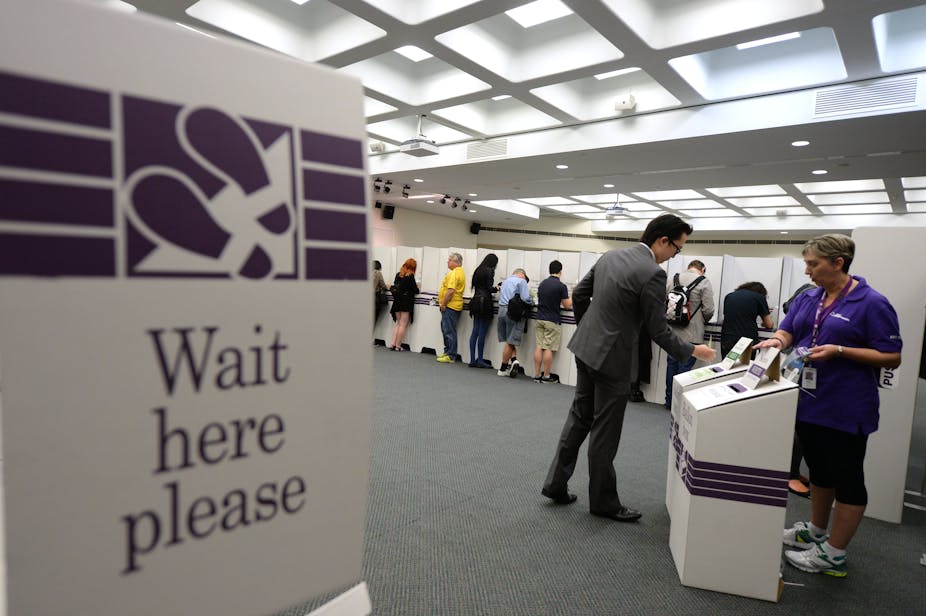The release of Mick Keelty’s report on the missing Western Australian Senate ballot papers from the 2013 federal election gives us an unusually in-depth look at how the Australian Electoral Commission (AEC) handles and counts votes.
Unfortunately for the AEC, the former top cop’s findings aren’t pretty. Keelty identified a string of issues in how ballot papers from that state were collated, transported, labelled and secured. He found that AEC policies were either unclear or not adhered to at key points during the collection and count.
Because of this, Keelty ultimately ruled that it was impossible to say whether the 1375 missing ballots were deliberately removed, lost in transit or mistaken for rubbish and simply thrown away. This finding should rightly concern all Australian voters.
The Keelty report
The Keelty report offers 32 recommendations for the AEC to tighten its ballot management processes. Electoral Commissioner Ed Killesteyn has already indicated his agency will be accepting these in full. In the wider community, the loss of these ballot papers has sparked renewed demand for the introduction of electronic voting, as this is – perhaps mistakenly – seen as more secure and reliable.
But for my money, this whole event highlights something much more problematic about the way Australia’s electoral system is structured: that our floating election dates gives the electoral authorities so little time to organise one of the country’s largest and most complex logistical exercises.
As the AEC itself points out, running a federal election means hiring, training and mobilising around 80,000 temporary staff to run more than 9000 polling booths in every far-flung corner of Australia. The AEC has to print and distribute 43 million ballot papers and accompanying information on how to vote in 27 different languages, and it has to do much of this work within the 33 or so days after an election is formally called.
In 2013, things were complicated even further by the fact that the election date was originally set for September 14 and then brought forward a week by Kevin Rudd because it suited his party’s political strategising. In these circumstances, it is hardly surprising that Keelty found an atmosphere of confusion and corner-cutting within the WA operation. What is actually astounding is how well the AEC pulls it off most of the time.
So, if we’re serious about reforming the electoral system to ensure its integrity into the future, the conversation we really should be having is about moving to fixed election dates.
Why fix the date?
As with so many other aspects of our federal electoral system, Australia is unusual in combining short parliamentary terms with floating election dates. Many of the major parliamentary democracies and comparable Westminster systems have switched to four or five-year fixed terms, including the United Kingdom, Canada, Germany and much of continental Europe.
Australia’s states and territories have also been progressively moving in this direction. Only Queensland and Tasmania still allow the governing party to pick the election date.
Fixing parliamentary terms — and therefore election dates — is seen to have a number of important benefits.
Firstly, it removes the advantage that incumbent parties gain by being able to set the election date at a politically beneficial moment. Having longer fixed terms is also thought to encourage less short-term thinking amongst politicians as it greatly reduces the chance of snap elections.
Finally, and most importantly for electoral integrity, fixed terms give the electoral authorities more certainty about when an election will be held so that they can put in place rigorous processes for this. The logistics can be worked out well in advance: temporary staff can be hired to work on a specific date and fully trained ahead of this; appropriate counting facilities can be scoped and secured.
These are all areas where the Western Australian operation reportedly fell through. And it is only going to become harder to get these things right as Australia’s population continues to grow and spread out.
Introducing fixed terms is also probably the only way we will ever see the widespread introduction of electronic voting in Australia. The logistics of sourcing, installing, testing and operating more high-tech voting systems are simply too complex to manage with a floating election timetable as short as ours.

What are the obstacles?
There are two big obstacles apparently standing in the way of a transition to fixed terms in Australia.
Firstly, it is generally assumed that Australians would have to vote in favour of this change at a federal referendum. With just eight of the 44 referenda since federation succeeding, the odds of this seem pretty slim.
But when Canada moved to fixed terms in 2006, that country avoided a constitutional conflict by ensuring that the governor-general’s ability to dissolve parliament remained unchanged. The amended Canada Elections Act simply states that elections are to be held on the third Monday in October every four years unless the governor-general says otherwise, effectively introducing fixed terms without the need for a referendum.
A similar approach seems feasible in Australia, given the fairly broad wording of Part 1, Section 5 of our own Constitution.
There is also a question about what would happen to the Senate if the House of Representatives moved to fixed four-year terms. The Parliamentary Library has taken a good look at different ways to manage this and the pros and cons of each, but longer Senate terms might simply be a price we have to pay to maintain the overall integrity of our electoral system.
There is no question that the AEC has some work to do in fixing the problems Keelty’s report identifies and rebuilding trust with the Australian public. But if we want the AEC to keep delivering reliable and rigorous election results, it’s probably time to give it the best sporting chance to do so by moving to fixed election dates.

